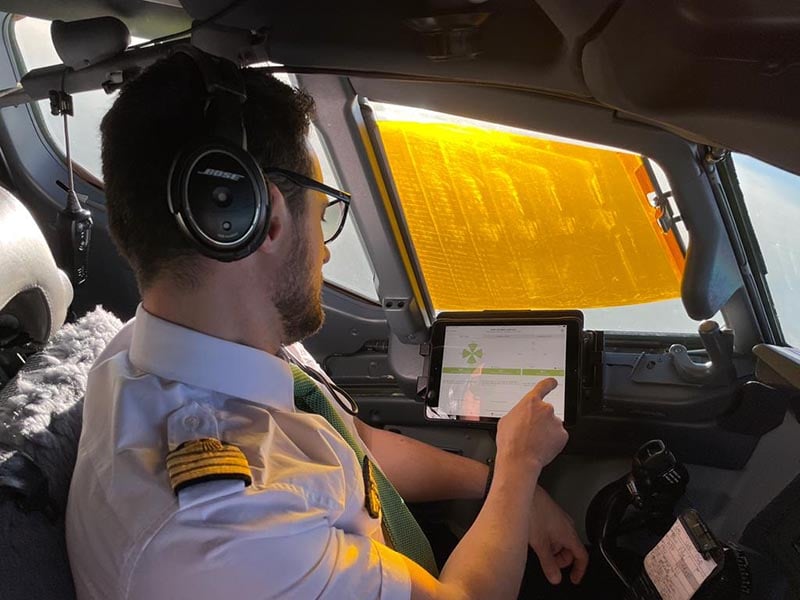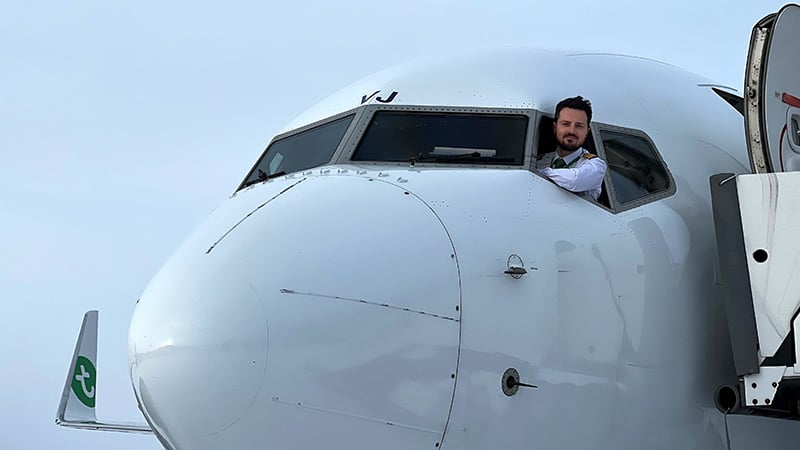Green Pilots: making aviation sustainable one best practice at a time!
Today, we celebrate World Pilots’ Day! We wanted to recognize all the men and women who act for the planet straight from the cockpit. Hugo Possamaï is one of them.
The 737 Captain at Transavia airline shares his passion for aviation and the environment on his channel High Pressure Aviation. He also joined the Green Pilot movement which units Pilots, airlines, and aviation enthusiasts to act for the planet.
We sat down with him to talk about sustainable aviation, and it turns out he has a few eco-flying tips up his sleeve!

Five eco-flying best practices that Captain Hugo Possamaï applies on a daily basis.
Could you give us some examples of fuel-saving best practices?
There are many fuel-saving best practices that pilots can apply depending on conditions. Some of them I do daily.
For example, EOTI, which stands for Engine out Taxi in. Its principle is to perform taxi with one engine shut down. We just need to respect a cooling time of 3 minutes to preserve engine life. It represents savings from 4kg to 6kg of fuel on each flight. At Transavia, the application of this best practice represents fuel savings of around 180t/year.
180t/year with one single initiative, that’s impressive! So this initiative is done on the ground. What about in-flight procedures?
For in-flight procedures, there is idle reverse thrust. It is one of the easiest to apply because we just need to apply idle instead of full reverse thrust just after landing for the deceleration of the plane. Keeping a safe margin regarding our weight and approach speed, idle reverse thrust is enough 99% of the time. Again, it represents another 10kg to 15kg of fuel saved on each flight and 480t/year at Transavia.
Are there any other inflight procedures that you apply?
There is also RAAL which stands for Reduced Acceleration Altitude. It takes place during the climb phase, just after takeoff. Usually, we must reach 3000ft to accelerate in most airports due to noise policies. However, at some airports, we can accelerate at 1500ft instead. The sooner we accelerate, the sooner we reach the clean configuration, reducing drag and improving fuel efficiency. It represents another 20kg of fuel on each flight and there is still room for improvement!
Transavia manages to save 360t/year through the RAAL application. They achieved these remarkable results thanks to monitoring this practice through SkyBreathe. They noticed the BP’s application numbers were low and identified the cause: communication. From then on, Transavia started to add the information in the flight files so the crew could access it easily and it was a real eye-opener.
These initiatives are based on the pilot’s actions. But sometimes, pilots are not the only ones involved in applying such procedures.
You’re right. For example, CDA, which stands for Continuous descent approach, is difficult to apply because it depends on ATC and traffic. What makes you burn a lot of fuel is the step-by-step descent. You adjust thrust to maintain your speed and flight path at each flight level. With CDA, we have a smooth constant descent at idle thrust instead of the many throttle adjustments required by the step-by-step clearances. This avoids much fuel burn. It is harder to apply at large airports, but when flying to small airports, there is always a chance to be allowed to perform it.
Any other initiatives related to ATC?
Yes, there are also Direct routes. We try to get direct routes during the flight to save both time and fuel. Every opportunity with ATC must be taken; we leave no stone unturned. Even if your route is prepared to be the shortest possible, you can sometimes get a shortcut and save a few minutes. It is another big perspective of saving fuel.

Captain Hugo Possamaï using the app SkyBreathe MyFuelCoach during a flight to monitor fuel best practices.
Is it easy to apply these best practices in your daily business life, or can it be challenging somehow?
In my experience, pilots who adopt eco-flying practices usually face two issues:
The first is the difficulty of staying engaged. Having the motivation to start is not difficult but keeping it overtime is. Few pilots consider it an additional workload during the flight. It is easier now that I am a Captain as co-pilots will follow my lead in applying these procedures.
The second issue is that it is hard to estimate success: even if you apply all the best practices in the world, how would you know you’re doing well? How would you measure success and progress? And ultimately, how much fuel do you save?
You probably know this famous quote from Lord Kelvin: you cannot improve what you cannot measure?
Exactly! Be aware and measure! These are the two reasons that led me to use MyFuelCoach. In my everyday life as a pilot, I am aware of the procedures I could follow or not. It also helps me build my experience as a young Captain.
It is exciting to see that pilots have many leverages to reduce fuel burn and CO2 emissions on flights. Thank you for sharing your expertise, Hugo!
LEARN MORE
Like what you see? Want to learn more about Engine-Out Taxi-In?


